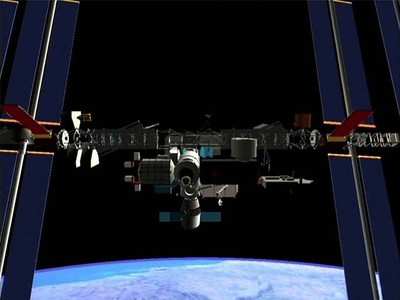Most Difficult Challenges Still Ahead
SpaceX reports that its Dragon spacecraft completed key on-orbit tests Thursday as part of a historic attempt to be the first commercial company in history to send a spacecraft to the International Space Station.

In the days since SpaceX’s Dragon spacecraft successfully launched from Cape Canaveral, Florida, the vehicle has steadily completed one task after another as it prepares to berth with the International Space Station. Only minutes after the spacecraft separated from the Falcon 9 rocket’s second stage, its solar arrays successfully deployed, providing power to the spacecraft. The door that had been covering sensors needed for proximity operations opened successfully.
On Tuesday and Wednesday Dragon traveled in orbit, firing its thrusters to catch up to the space station. During that time, the vehicle hit a series of milestones. Dragon showed its Absolute Global Positioning System (GPS) is in good working order. The vehicle demonstrated both a pulsed and a full abort. It also demonstrated free drift, floating freely in orbit as it will when grappled by the space station’s robotic arm. And its proximity operations sensors and SpaceX’s COTS UHF Communication Unit (CUCU) are up and running.
Early Thursday morning, Dragon’s thrusters fired, bringing the vehicle 2.4 kilometers below the International Space Station. The vehicle completed two key tests at that distance. Dragon demonstrated its Relative GPS and established a communications link with the International Space Station using CUCU. Astronauts commanded on Dragon’s strobe light to confirm the link worked. With these tests complete, Dragon has started the trip flying around the space station, returning the spacecraft to its original approach location.
Dragon has been performing well, but the company says the most difficult aspects of the mission are still ahead.

Around 0500 EDT Friday, NASA will decide if Dragon is GO to move into the approach ellipsoid 1.4 kilometers around the space station. If Dragon is GO, after approximately one hour Dragon will move to a location 250 meters directly below the station. Dragon will then perform a series of maneuvers to show systems are operating as expected. If NASA is satisfied with the results of these many tests, Dragon will be allowed to perform the final approach to the space station.
Sometime around 0900 EDT, astronauts on the space station will grapple Dragon with the space station’s robotic arm and the spacecraft will attach to the station. If all goes well, at approximately 0500 EDT Saturday, the crew will start procedures to open Dragon’s hatch. It will take around 2 hours to complete all operations leading to the hatch opening. Once the hatch is opened, astronauts will enter Dragon for the first time in space. SpaceX cautions that all dates and times are approximate and could easily change.
This is SpaceX's second demonstration flight under a 2006 Commercial Orbital Transportation Services (COTS) agreement with NASA to develop the capability to carry cargo to and from the International Space Station. Demonstration launches are conducted to determine potential issues so that they might be addressed; by their very nature, they carry a significant risk. If any aspect of the mission is not successful, SpaceX says it will learn from the experience and try again. (Images: Top, NASA photo of Dragon taken from ISS. Bottom, artist's concept of Dragon docked with ISS)
 Unfortunate... ANN/SportPlane Resource Guide Adds To Cautionary Advisories
Unfortunate... ANN/SportPlane Resource Guide Adds To Cautionary Advisories ANN FAQ: Turn On Post Notifications
ANN FAQ: Turn On Post Notifications ANN's Daily Aero-Term (04.29.24): Visual Approach Slope Indicator (VASI)
ANN's Daily Aero-Term (04.29.24): Visual Approach Slope Indicator (VASI) ANN's Daily Aero-Term (04.28.24): Airport Marking Aids
ANN's Daily Aero-Term (04.28.24): Airport Marking Aids ANN's Daily Aero-Linx (04.28.24)
ANN's Daily Aero-Linx (04.28.24)




